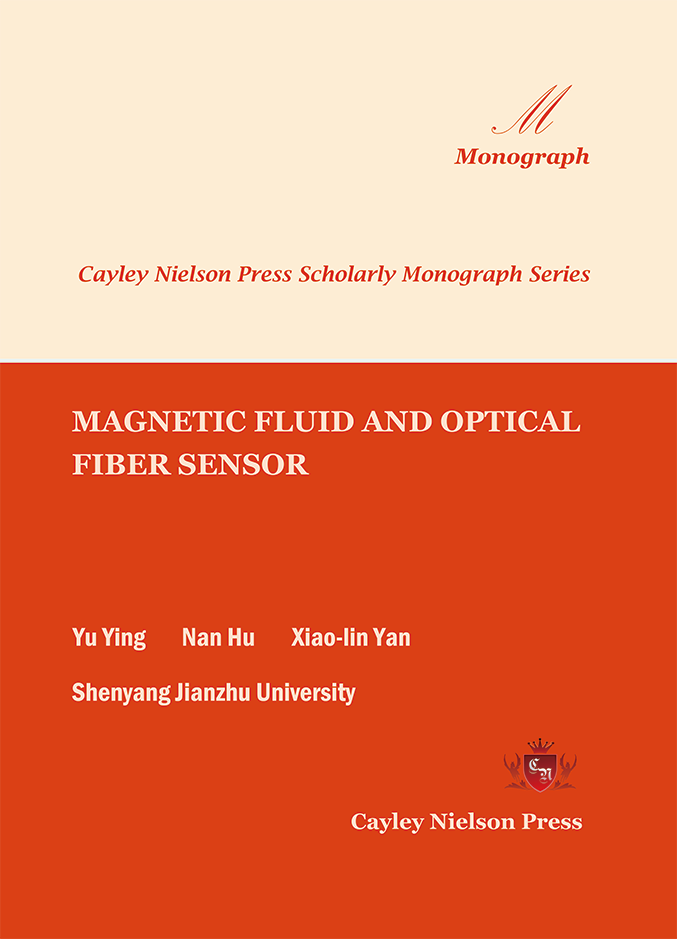
MAGNETIC FLUID AND OPTICAL FIBER SENSOR

MAGNETIC FLUID AND OPTICAL FIBER SENSOR
Author: Yu Ying, Nan Hu, Xiao-lin Yan
Shenyang Jianzhu University
Copyright © 2022 by Cayley Nielson Press, Inc.
ISBN: 978-1-7348822-8-5
Cayley Nielson Press Scholarly Monograph Series Book Code No.: 212-2-1
US$179.30
Preface
Magnetic fluids (MF), which is also called ferrofluid or magnetic liquid, is a new type of functional material. It has both the magnetism of solid magnetic material and fluidity of liquid material. It is a kind of stable colloid that the magnetic nanoparticles dressed with surfactant highly dispersed in one kind of carrier liquid. Magnetic fluids has so many unique properties that it develops quickly in various research area. The early study of magnetic fluids was in the 1960s, and now it goes deep into the areas of electronic, energy, aerospace, national defense, metallurgical machinery, chemical engineering and environment protection, instrumentation, health and medical community and so on. Nowadays, the research on the optical properties of the magnetic fluids is still hot research topic around the world.
Optical fiber sensor has been a research focus, due to excellent sensing and physical characteristic. The optical fiber sensors have certain advantages that include immunity to electromagnetic interference, lightweight, small size, high sensitivity, large bandwidth, and ease in implementing multiplexed or distributed sensors. Strain, temperature and pressure are the most widely studied measurands and the fiber grating sensor represents the most widely studied technology for optical fiber sensors. Fiber-optic gyroscopes and fiber-optic current sensors are good examples of rather mature and commercialized optical fiber sensor technologies.
The contents of the book are organized into five chapters. In chapter 1, aimed to use a new molecular dynamics model based on rod-like magnetic nanoparticles, and the microstructure was simulated in terms of both translations of nanoparticles and rotations of magnetic dipole moments. In chapter 2, Molecular Dynamics (MD) method based on spherical and Rod-like magnetic nanoparticle was respectively used to compute the microstructure of magnetic fluid. In chapter 3, a high sensitivity temperature and magnetic field sensor based on surface plasmon resonance (SPR) in dual-core D-shaped photonic crystal fiber (PCF) with two different air hole diameters is proposed. In chapter 4, a high-sensitivity refractive index sensor based on D-shaped PCF with Graphene-PMMA deposited platform was proposed. In chapter 5, a double D shaped optical fiber for simultaneous temperature and relative humidity (RH) sensing is proposed. In chapter 6, we have investigated a novel method of CODs detection by computing the peaks area of Brillouin frequency and analyzing the relation between peak areas.
I wanted to thank the authors of the book chapters, especially You Xia, Zhi-jun Gao, Jia Lin Sun, Feng-Yan Han, Tian-Bo Xu, Xi-Feng Guo, because they offered to nano materials and technology applied to many areas of the latest progress and the existing challenges.
YuYing
Shenyang Jianzhu University
Shenyang, Liaoning, China
July 24, 2021
Contents
1 Theoretical research on microstructure and optical properties of magnetic fluid composed of rod-like shape nanoparticles 1
1.1 Introduction 1
1.2 Model of molecular dynamics method for magnetic fluid 3
1.3 Simulations for magnetic fluid microstructures 6
1.4 Optical transmission properties of magnetic fluid 10
1.5 Conclusions and Discussions 15
2 D-shaped tilted fiber Bragg grating using magnetic fluid for magnetic field sensor 16
2.1 Introduction 16
2.2 Simulation model of magnetic fluid 18
2.3 Simulation results and physical interpretation 20
2.4 Conclusions 23
3 Temperature and magnetic field sensor based on SPR in dual-core D-shaped PCF 24
3.1 Introduction 24
3.2 Structure design and theoretical model 26
3.3 Results and discussions 29
3.3.1 Analysis of resonance point. 30
3.3.2 Effect of different kinds of metal films and metal rings on optical properties. 32
3.3.3 Effect of big air hole diameter on optical properties. 34
3.3.4 Effect of small air hole diameter on optical properties. 36
3.3.5 Effect of different thicknesses of gold film and gold ring on optical properties. 37
3.3.6 The results and analysis of temperature and magnetic field intensity changes respectively. 38
3.3.7 Cross-sensitivity analysis of temperature and magnetic field 40
3.4 Conclusions 41
4 Sensing performance and optimization of D-shaped photonic crystal fiber with Graphene-PMMA deposited platform4 42
4.1 Introduction 42
4.2 Design and theory 44
4.3 Result and Discussion 45
4.4 Conclusions 51
5 Temperature and humidity sensor based on a double D shaped optical fiber with incorporated toluene and polyethylene 52
5.1 Introduction 52
5.2 Design and theoretical background 54
5.3 Results and discussions 56
5.4 Conclusions 63
6 Prediction of crack opening in steel beam based on strains measured from distributed optical fiber sensor 64
6.1 Introduction 64
6.2 Theoretical principles 66
6.3 Experimental program 71
6.4 Results and Analysis 73
6.5 Conclusions 78
References 79
Readership
This book should be useful for students, scientists, engineers and professionals working in the areas of optoelectronic packaging, photonic devices, semiconductor technology, materials science, polymer science, electrical and electronics engineering. This book could be used for one semester course on adhesives for photonics packaging designed for both undergraduate and graduate engineering students.
